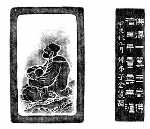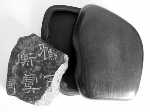She ink slabs are made of gray, light green, or rare black slate with markings, the stone looks layered and is hard. She ink slabs have three features: they form ink quickly, don't harm the brush, and keep the ink wet.
She ink slabs have a special artistic style with different markings resulting from geological changes over time. Typical markings are Gold Star, Gold Star Patch, Gold Line, Silver Star, Silver Line, Cherry Blossom Gold Star, and Small Water Wave. Rarer ones are Eyebrows,JadeBelt, Jade Belt with Gold Star, Big Water Wave, Fish Egg, Dates Kernel Eyebrows, Jade Patch, etc.
Anhui Province was part of an ocean 13 billion years ago. Through glacial and volcanic movements, mud and other substances formed these rare ink slab slates. This is part of the reason why she ink slabs are so costly.
|
|
|
|
| Chengni ink slab owned by Jin Nong, a member of "Eight Eccentrics of Yangzhou" of the Qing Dynasty. | A Qing ink slab made from an incomplete stele of the Eastern Han Dyansty. | Zhao Mengfu's Duan ink Slab. |
Chengni ink slab owned by Jin Nong, a member of "Eight Eccentrics of Yangzhou" of the Qing Dynasty. A Qing ink slab made from an incomplete stele of the Eastern Han Dyansty. Zhao Mengfu's Duan ink Slab.
Gansu Tao Ink slab
Tao ink slabs from Lanzhou,Gansu Provincein west China are acclaimed as one of the Four Famous Ink Slabs in China, along with the duan ink slabs ofGuangdong Province, the she ink slabs of Anhui Province and the chengni ink slabs of Shanxi Province. Tao ink slabs have a long history and became famous during the Song Dynasty (960-1279).
Produced mainly in Taoyan Village in Zhuoni County, Tao ink slabs are made of stone found at the bed of the Tao River; hence the name. It has four main kinds: Duck-Head Green, the best of the four in terms of quality, with light green, water-like lines and hard in nature; Parrot Green with a dark green and smooth surface; Osier Green in green mixed with vermilion, and with hard nature; and Light-Green, featuring the flowing lines of water.
One feature common to all four kinds of ink slabs is that the stone is hard and fine. Though hard, the stone is not dry. Though fine, it is not slippery. With a hard, smooth stone you can produce liquid ink easily by rubbing the ink stick against the stone. Because the stone is fine, but not slippery, it yields ink very quickly.
The ink slab's fame lies in its beauty and style and good quality, usually decorated with various fancy pictures of things likedragons, phoenix, tortoises, mountains and water, figures, flowers and birds. In the past, it was a favorite collectable of celebrities. The Gansu authorities choose Tao Ink Slab as a present to the Special Administrative Government whenHong Kongofficially returned to China in 1997. The most famous aspect of the ink slab is that when its lid is on, the lines and patterns of the original stone merge with the lid line to give the impression that the stone is whole.
Guangdong Duan Ink Slab
Produced inZhaoqing, Guangdong Province in south China, duan ink slabs are another of the Four Famous Ink Stones.
According to historical documents, duan ink slabs were first produced during the Wude reign (618-626) of the Tang Dynasty (618-907). They are made of duan stone from the Duanxi River running along the foot of Lanke Mountain, hence the name. Famed for their fineness and for not harming the brush, duan ink slabs have earned a high reputation among Chinese scholars.
The procedure to make a duan ink slab has four steps: stone picking, selection, engraving and box matching; of which stone picking and engraving are the two most important. It is very hard to handpick flawless stones, and other alternative tools such as dynamite are forbidden. Engraving stresses the good origin and fine shape of the stones. Engravings are usually of flying dragons, flowers, birds, figures, mountains and water. The matching boxes are also very delicately chosen, and are often made of purple sandalwood and rosewood.
Duan ink slabs have various styles, and new-style products are designed one after another, such as doufang ink slabs -, engraved rectangular ink slabs and engraved natural ink slabs, etc. In recent years, lots of ink slabs with an old look have been produced to meet increased export demands.













